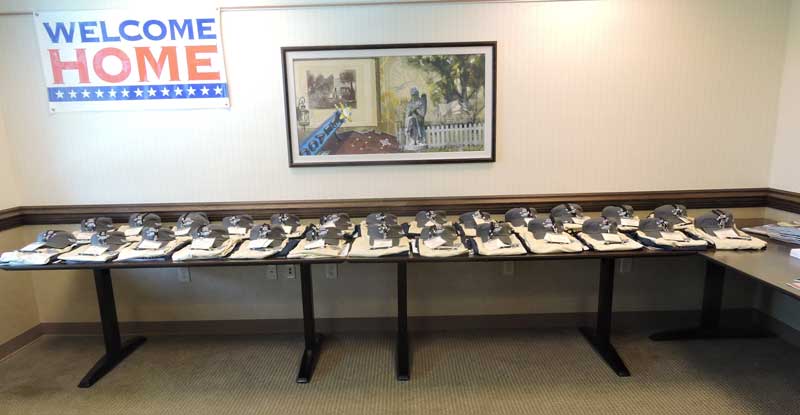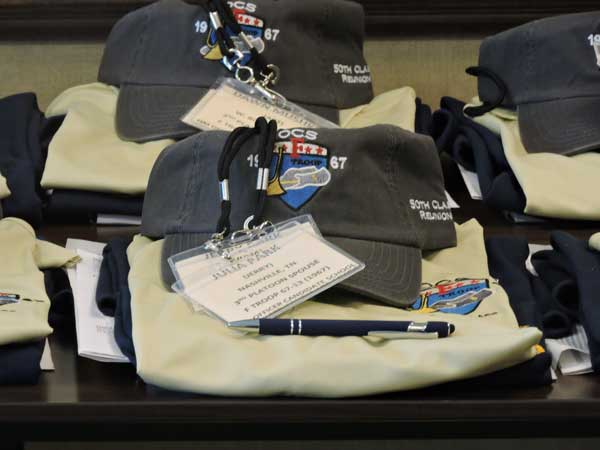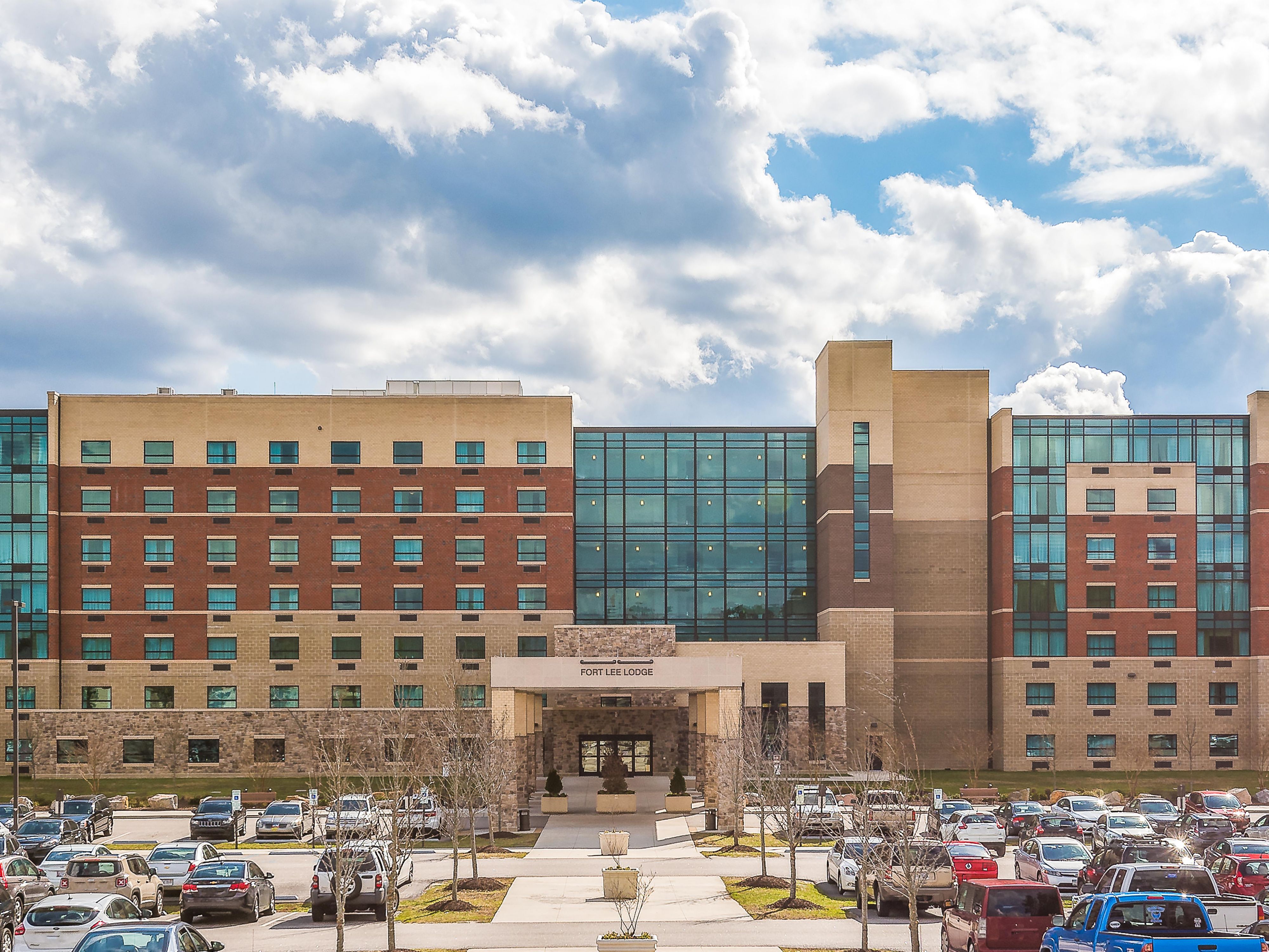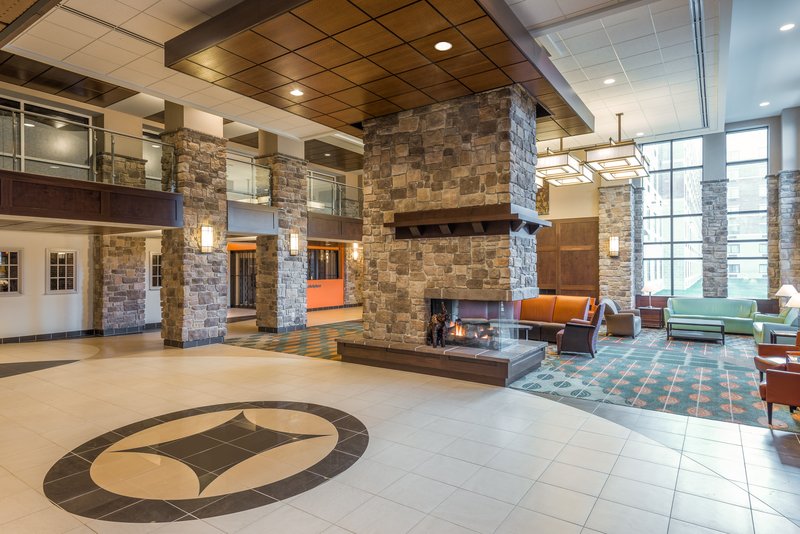| 50th Reunion Attendees |
The following classmates and cadre were in attendence:
| | | |
| 1 Baetz, Dave (2) | 2 Benkowitz, Steve (2) | 3 Chernesky, George (2) | 4 Clark, George (1) | | 5 Cole, Carey (2) | 6 Comfort, Guy (2) | 7 Conrad, Ron (2) | 8 Corder, Phil (2) | | 9 Dachelet, Ron (2) | 10 Eastmond, Tony (1) | 11 Ell III, Ed (1) | 12 Gangemi, Rick (1) | | 13 Hall, Peter (2) | 14 Hancock, Les (1) | 15 Horn, Dave (2) | 16 Libby, Harry (2)* | | 17 Maher, Ed (2) | 18 Murray, Dick (2) | 19 Mushkin, Art (2) | 20 Park, Jerry (1) | | 21 Parmiter, AJ (1) | 22 Rodilosso, Phil (2) | 23 Roman, Frank (2) | 24 Tucker, Tuck (2) | | 25 Urbano, Mike (2) | 26 Wardell, Jay (2) | 27 Warner, John (2) | 28 Wile, Jere (2) | | 29 Williams, Ron (2) | 30 Yount, Alan (2) |
* = Guest
|
|
| |
|
| 50th Reunion Schedule |
|
Hotel Breakfast Times: Breakfast is served in a room near the check-in desk and is served from 6:00am to 9:00am. There will be lots of other
people there so give yourself plenty of time especially the first morning. They usually have oatmeal with cinnamon, walnuts & raisins for
toppings or biscuits & gravy; donuts; muffins; hard boiled eggs; bagels & cream cheese or peanut butter; yogurt; cold cereal (milk is next to
the cereal); Ego waffles you put through the toaster machine. The coffee and soda drink machines are on the left as you enter the large sittin
area. the food area. Decaf coffee is available at the coffee station located near the hotel entrance doors by check in desk.
|
Tuesday August 29
- 8:45 am - Be on the first floor near the check-in Desk
- 9:00 am - Be on board the bus in front of the Ft. Lee Hotel ready to leave - WE MUST BE ON TIME
- 9:15 am - 9:50 am - Indoor laser rifle range where we will fire the M-16 or M-4 rifle
- 10:00 am - 11:15 am - HUMMV convoy scenario where we come under attack & make decisions
- 11:30 am - 12:15 pm - Lunch at the huge Ordnance DFAC with 3 serving lines, salad bar & dessert bar
- 12:30 pm - 1:45 pm - Tour the Rigger parachute facility see packing and specialty chutes with GPS's
- 1:55 pm - 3:45 pm - Tour the QM Museum with exhibits from F Troop, WWI and QM history
- 3:45 pm - return to the Ft. Lee Hotel to prepare for the F Troop Banquet at the old Ft. Lee Officer Club
- 5:45 pm - board the bus and go to the Ft. Lee Club
- 6:00 pm - open bar available and more reminiscing prior to the banquet. Seating chart will be posted.
- 7:00 pm - Banquet dinner, speeches by BG Rodney Fogg, the QM General, CPT Benkowitz and COL Cole
- 10:00 pm - approximate time to return by bus to the Ft. Lee Hotel
Wednesday Aug 30
- 9:15 am - Be on the first floor near the check-in Desk
- 9:30 am - Be on board the bus in front of the Ft. Lee Hotel ready to leave - WE MUST BE ON TIME
- 9:40 am - 11: 30 am - Presentation by Dr. Steve Anders, retired QM Historian, contrasting changes in operations including Quartermaster from the Vietnam war to the Middle Eastern wars
- 11:45 am - 12:30 pm - Lunch at the huge Ordnance DFAC with 3 serving lines, salad bar & dessert bar
- 12:45 am - 1:45 pm - Ordnance Robotics Lab where we will play with the bomb defusing robots
- 2:00 am - 3:00 pm - Tour the Executive Chef Culinary School where some have gone to the Whitehouse
- 3:15 pm - 3:45 pm - Tour a Marine barracks near our old barracks to contrast the differences
- 4:00 pm - 4:45 pm - Tour our old barracks B-9303A and our mess hall
- 4:50 pm - 5:10 pm - Get into formation & stand F Troop's last retreat ceremony behind our old barracks & retire our guidon to BG Jeffrey W. Drushal, Chief of Transportation who will retire it to the QM Museum.
- 5:15 pm - return by bus to the Ft. Lee Hotel and participate in a free meat ball subs, sides and drinks dinner, more reminiscing with F Troopers, turn in your F Troop memory spiral notebook and name tags.
Wednesday Aug 30
- Check out or stay a few days for sightseeing-your car pass is good from 8/24 thru 9/2
- Results - You will have experienced a fantastic walk through memory lane and renewed old acquaintances!
Lunch choices at the Ft. Lee Dining Facility:
Make your choice in advance so you can get in the proper line (Entrée Line, Deli Sandwich Line or Short Line) because we only have 45 minutes
in the facility so we must move through and eat quickly. Carey will be paying for everyone so you just need to get your food and move to the
salad bar, dessert bar and drink station. You will be shown where to sit.
Tuesday: each line also includes a salad bar, dessert bar and drink station
- ENTRÉE LINE: Broccoli, cheese & rice; Roast Pork loin; Baked Salmon or Baked Chicken - each with starch & vegetable
- DELI SANDWICH LINE: Tuna, Turkey, Roast Beef or Ham - each with choice of bread
- SHORT LINE: Pasta bar
Wednesday: each line also includes a salad bar, dessert bar and drink station
- ENTRÉE LINE: turkey roast; Italian beef rice; pasta primavera; Cornish hen
- DELI SANDWICH LINE:Tuna, Turkey, Roast Beef or Ham - each with choice of bread
- SHORT LINE:T-bone steak & potato
|
|
|
Fort Lee Traveler Article
Pictures and article in the 9/7/17 Fort Lee Traveller by T. Anthony Bell, Senior Writer/Special Projects
|
Return to Hell: Officer grads reflect on tough training in preparation for war in Vietnam
|
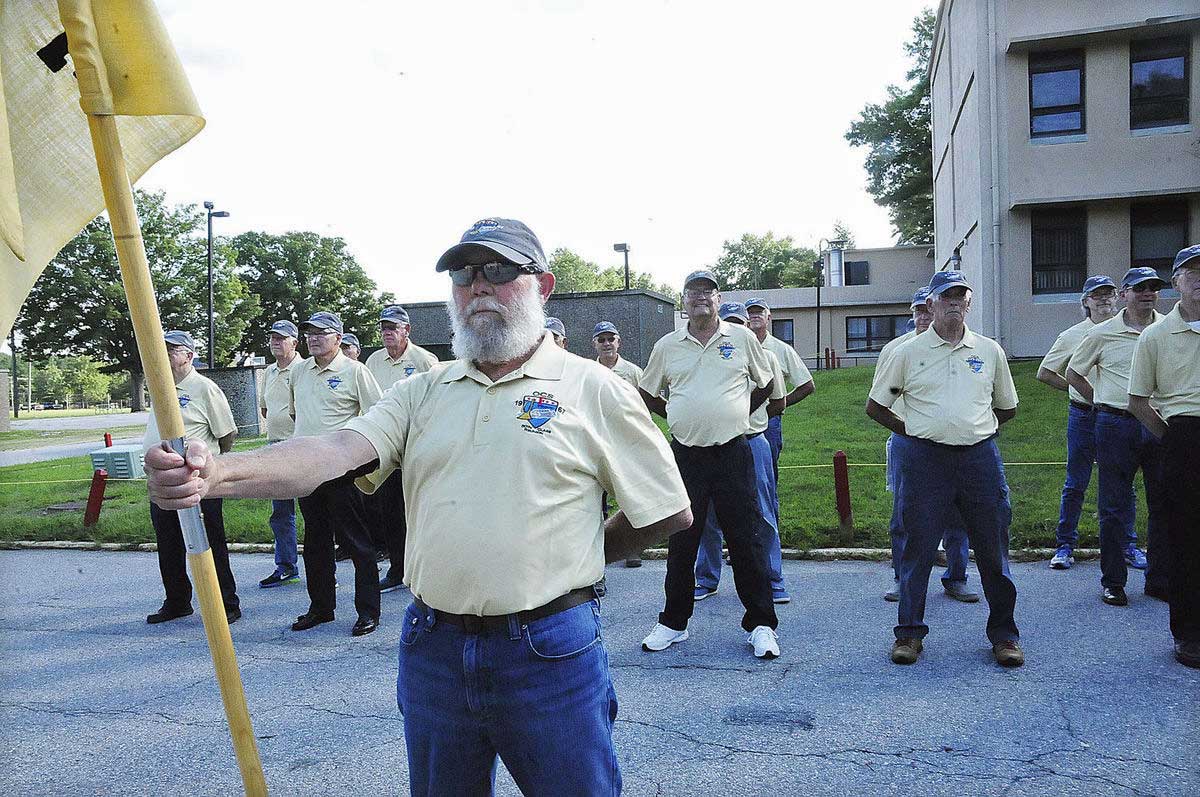 |
Jerry Wile, guidon bearer, and his fellow Class 13-67 classmates stand at the position of parade rest just before a retreat
ceremony Aug. 30 at the group's former barracks on A Avenue. The members of Quartermaster Officer Candidate School Class 13-67
were here Aug. 28-31 to celebrate their 50-year anniversary.
|
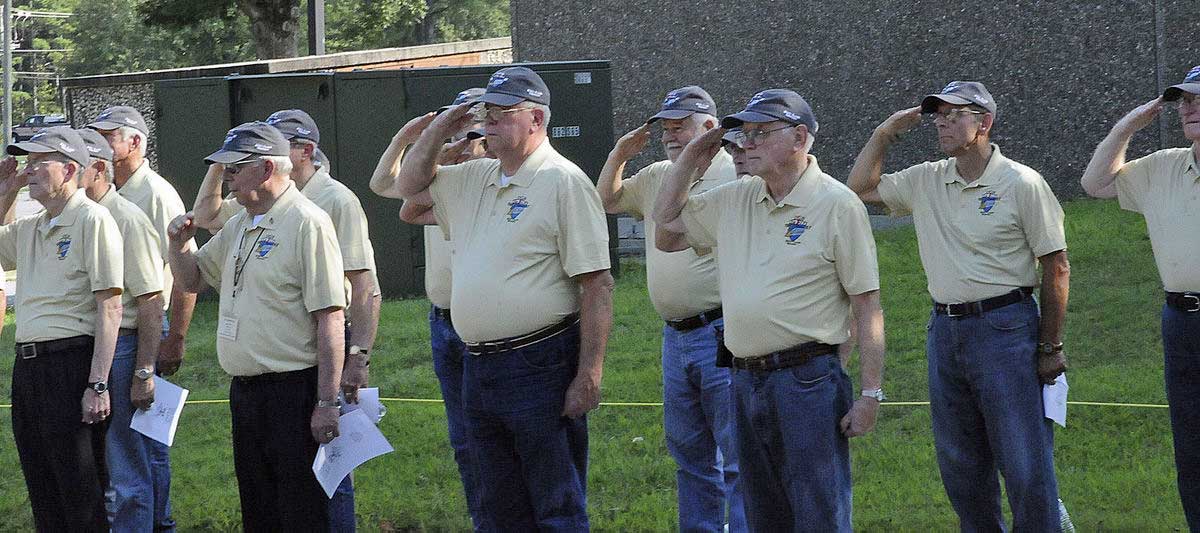 |
| |
Class 67-13 members talk with Brig. Gen. Jeffrey Drushal, Chief of Transportation, just before a Retreat ceremony retiring the
F Troop colors for archival at the Army Quartermaster Museum Aug. 30. Drushal presided over the ceremony.
|
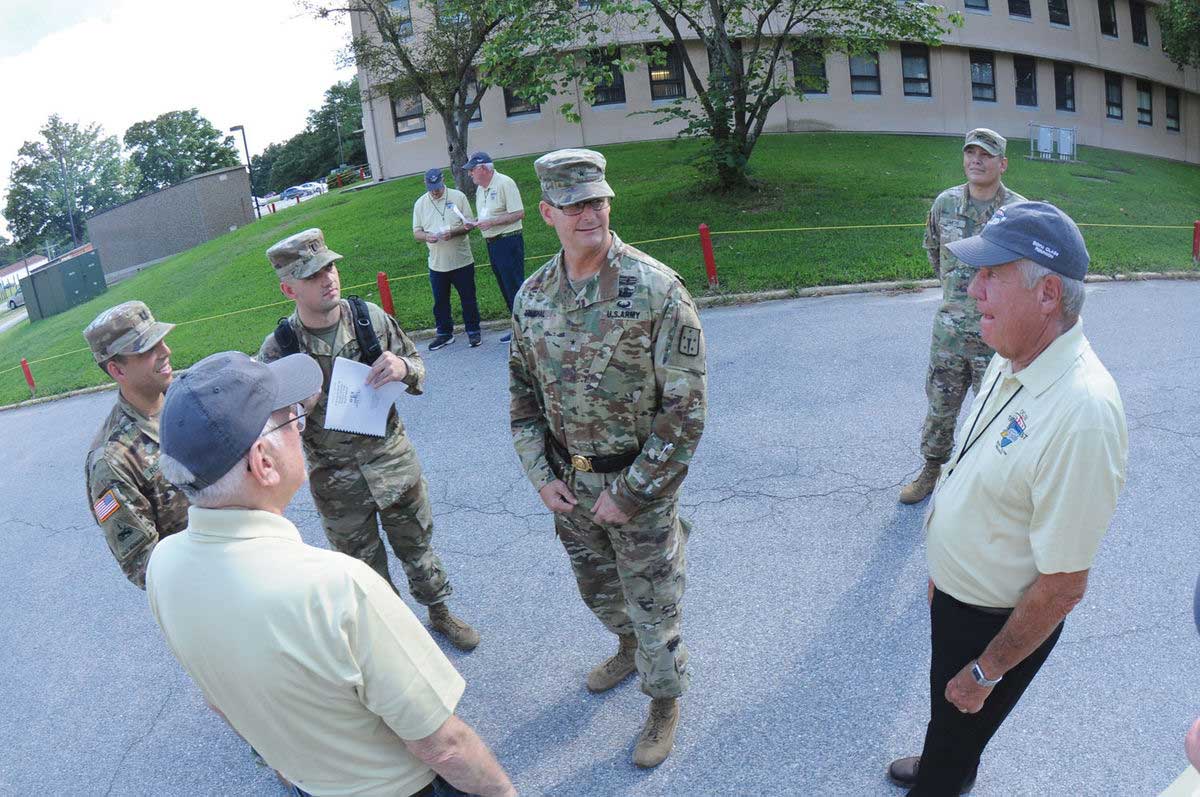 |
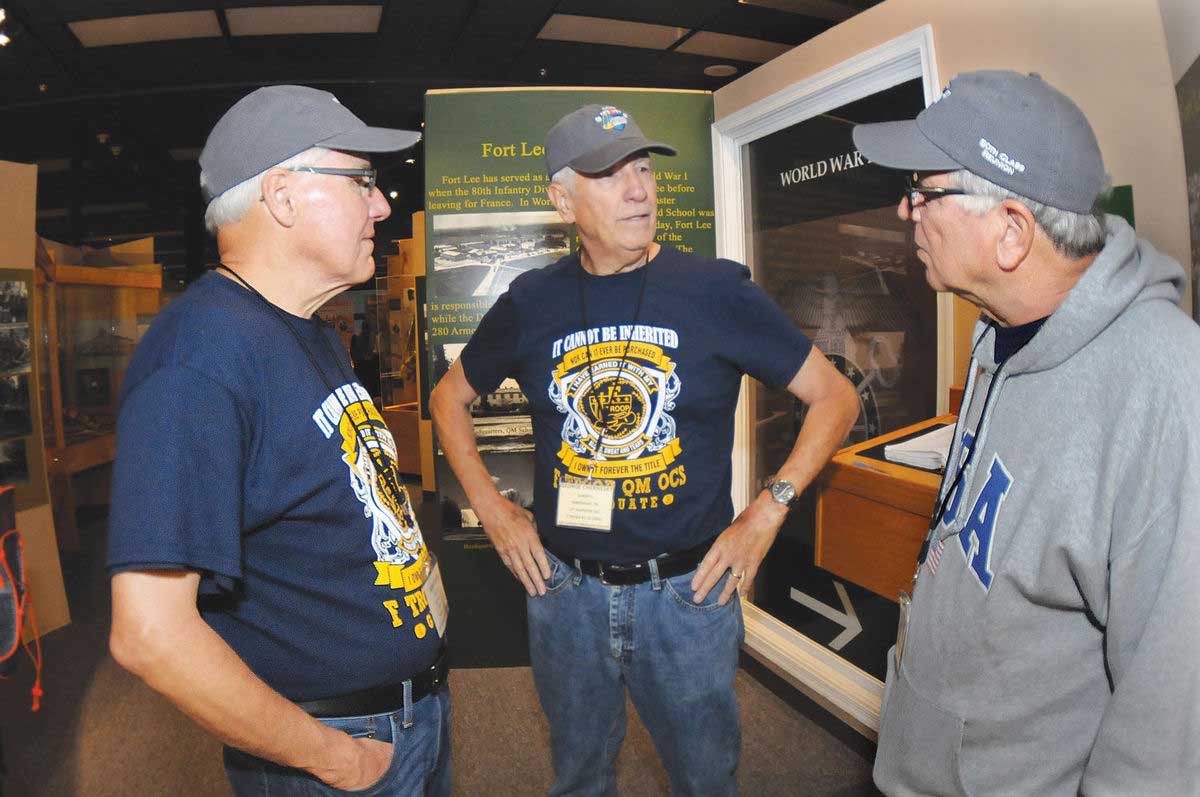 |
Ron Conrad, retired Lt. Col. George Chernesky and Mike Urbano converse at the Army QM Museum on Aug 29. Conrad and Urbano are
graduates of Class 67-13. Chernesky was a member of the Cadre. The three were attendees of the class' 50-year reunion here
Aug 28-30.
|
|
Luther D. Hanson, curator, Army Quartermaster Museum, leads Quartermaster Officer Candidate School Class 13-67 Reunion
attendees through a tour of the facility Aug. 30. The group washereAug 28-30 in a celebration of its 50-year anniversary.
|
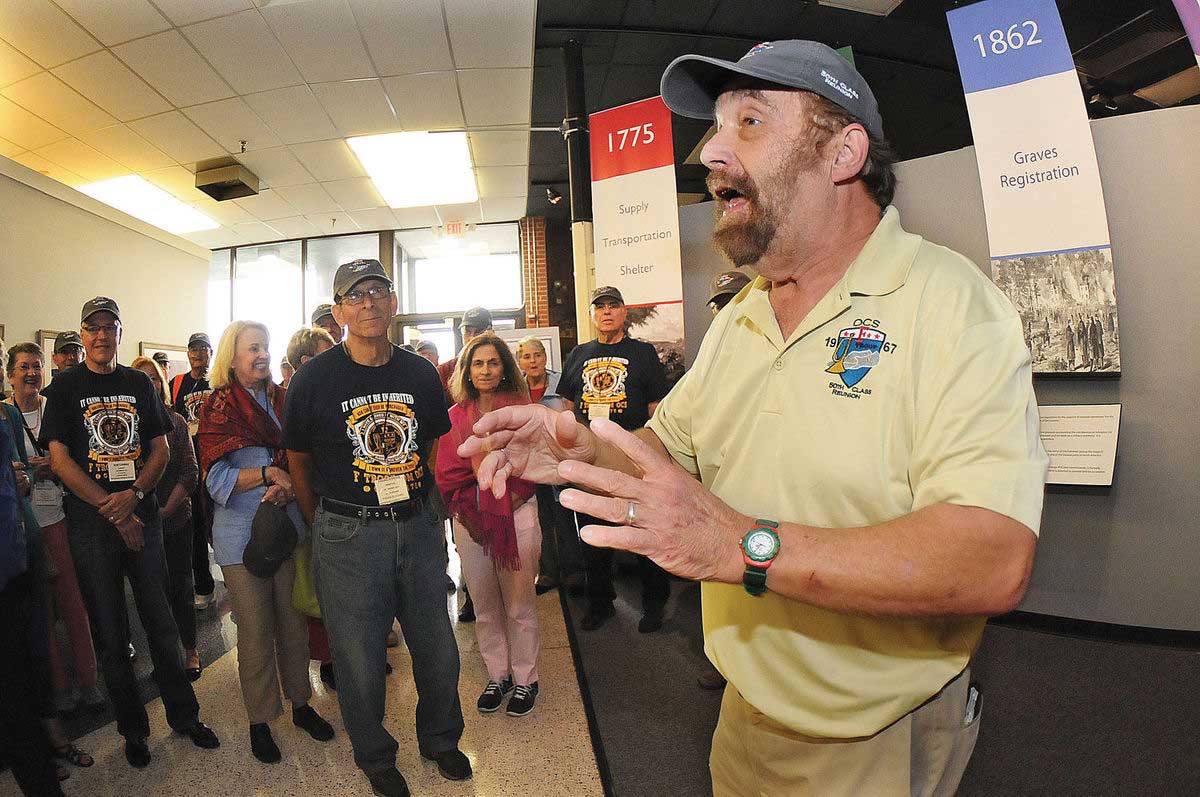 |
FORT LEE, Va. (Sept. 7, 2017) -- In 1966, the Vietnam War roster of required personnel was ramping up to peak numbers of more
than 500,000. The Army in response began training its Soldiers under the premise they would see combat in Southeast Asia.
The cadre assigned to Foxtrot Company, Quartermaster Officer Candidate School Class 67-13, went about the mission of preparing
its candidates for war at a much higher standard.
The result? A gauntlet-like training experience - 23 weeks of spit and polish, constant double-timing and cadre harassment worthy of
removal in today's Army - played out over the looming prospect of survival on a Vietnam battlefield.
Those experiences were recalled here Aug. 28-31 as 27 graduates from Class 67-13 (also known as F Troop) celebrated their third reunion.
The event featured informational briefings, tours of various training facilities, including those operated by the Quartermaster and
Ordnance schools, and a visit to the Army Quartermaster Museum.
Retired Col. Carey E. Cole, F Troop Reunion coordinator, was grateful for
the accommodations.
"I think everything is fantastic," he said Aug. 30 on behalf of the cadre and graduates, some of whom traveled with spouses. "... We've
been impressed by everybody from the generals on down to the privates."
Cole and 154 others were assigned to F Troop in the winter of 1967. Only 77 survived to graduate 23 weeks later. Many hold dear to their
hearts the shared experience that marked their lives forever.
"We developed a bond that really can't be compared to anything else, other than perhaps a unit that was in combat or something like that,"
said Cole. "You develop a closeness. During OCS, almost all of us at one time or another thought about quitting, but your buddy would say,
'Come on, Carey, stick with it. You can make it.' Over half of them didn't. They just dropped out. And they didn't just drop out, they
flunked out; they couldn't take the pressure."
Those who could not handle the pressure were consequential to the process of producing Soldiers who could best equip themselves on the
battlefields of Southeast Asia, said Cole.
"In Vietnam, there were no frontlines," he said. "You could be in a base camp and be overrun. You needed to learn to act accurately and
quickly in order to save your life and the lives of your men."
It was not, however, consistent with the attrition rates amongst the entire brigade
"They were graduating 80, 90, 95-percent of their companies," said former Capt. Steve Benkowitz, the F Troop company commander at the time.
"I said I don't know what our percentages are going to be, but everyone who graduates (in this company) we're going to be proud to salute
as an officer."
Benkowitz focused on discipline, team unity and how to respond in stressful situations. First Lt. George Chernesky was one of three cadre -
called training advisors and counseling officers - who relentlessly carried out Benkowitz' intent.
"My job was to prepare them to go to war, to be successful at war, and to be a successful leader in war," he said. "That was all part of it.
It wasn't to harass them or any other thing but to prepare them to be leaders, men, able to accomplish the mission and not have people killed
under their watch.
"You have to be able to focus, think and do the right thing even when adversity is slapping you in the face."
During the course, adversity was created with the force of painful jabs rather than slaps, said Cole. He remembered how the TACs made them
run back to the barracks from a day at the range rather than ride the bus.
"It had been raining and the ditches were full of muddy water," he said. "Every time we came to a ditch, we had to low-crawl through it,
and at the end of the ditch we had to take off our helmet liners, dip it in the water and pour it over our head. We had to do that numerous
times on the way back to the barracks.
"We arrived back to the barracks right near Retreat. All the other companies were lined up in their starched fatigues and here we come running
in front of all the companies looking like a moving mud ball. We were singing, yelling in cadence and carrying on. The expressions on the faces
of the other candidates was unlike anything we'd ever seen. They were like, 'Holy cow, there goes F Troop.'"
Low-crawling through muddy ditches in today's Army could result in someone getting relieved of duty. Jerry Wile, who eventually spent six months
in Vietnam, said those type of tactics were dished out routinely.
"When we first got here, they just hazed the hell out of us," he said, "and they hazed us hard. I mean, we didn't get any sleep and we had
to run, run, run everywhere. We'd go for inspection and they'd rip up our stuff. We'd go for inspection again, they'd rip up our stuff again.
This would go on every single night."
In the haze of course survival, anger was directed at the TACs, said several graduates. Phillip Corder is one of those who had a certain disdain
for his TAC, 1st Lt. Tony Eastmond.
"At the time, I'd liked to have pinched his head off," he recalled.
A similar sentiment was directed toward the career Soldier Chernesky, who, said several attendees, was a menacing terror. Attendee Frank Roman
said he certainly had his differences with him during his time as a student. During the group's visit to its old barracks Aug. 30, Roman said
Chernesky's ghostly presence still cast a measure of darkness about the hallways. He said he earlier told his former TAC he "enjoyed his job a
little too much."
Despite the TACs's looming shadows, Wile said he and others finally figured out the cadre strategy and made the necessary mental adjustments
to survive the training.
"Ultimately, we figured out it was a game for them and a game for us, and it was a question of who had the right perspective," he said. "The
ones who didn't have the right perspective washed out."
During the reunion, most of the attendees said they are now thankful for the resolve their trainers demonstrated. Corder, the student who wanted
to "pinch" off the head of his TAC during his training, doesn't feel the same way today.
"Now, I love him, Lordy mercy," said the Army retiree of Eastmond. "We communicate at least three times a week, still. That's been 50 years."
Mike Urbano, who was trained by Chernesky, said purpose and objective is fleeting during training and emotions are raw, but it wasn't until
later during his career when his OCS teachings came into clear view.
"I think the TAC officers were instrumental in all of us," he said. "… Every day I was in the service, every day I was an officer, I thank
God I was able to go through that stuff and be able to control guys I was responsible for," he said. "That was important to all of us, and
I think we learned a good lesson here."
Jay Wardell, who used the word "hell" to describe his OCS experience, said the training paid dividends in the theater of operations,
specifically Quang Tri, Vietnam, where he served a one year tour with the 101st Airborne Division.
"I was glad I'd gone through the training I had," said the Littleton, Colo., resident. "Things changed every minute when you were in that kind
of situation. When you look back on it, you say 'thank you.'"
As it turned out, 44 percent of the graduates found themselves in Vietnam after the training. All returned home. Some went on to spend careers
in the Army and others served their hitch and returned to civilian life. Cole said the training experience was bigger than its stated purpose.
"I learned I could do a lot more, and I can take a lot more than I ever thought I could," he said. "I think everybody came away with that same
feeling. Almost everyone who graduated from F Troop has been very successful in their military and civilian careers. We have CEOs, doctors,
managers, plant owners, etc.
"We just have a camaraderie you really can't explain. You would have to experience something like we went through to understand it."
|
|
